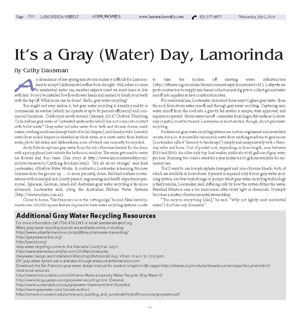|
|
Published July 2nd, 2014
|
It's a Gray (Water) Day, Lamorinda
|
|
| By Cathy Dausman |
|
|
An abundance of late spring rain storms makes it difficult for Lamorindans to accept California still suffers from drought. Still, when it comes to residential water use, weather experts insist we must learn to live with less. So you've installed low flow shower heads and learned to brush your teeth with the tap off. What more can be done? Hello, gray water recycling!
 You might not even realize it, but gray water recycling is already a reality in commercial car washes (which can operate at up to 95 percent efficiency) and commercial laundries. California's newly revised (January, 2014) Uniform Plumbing Code defines gray water as "untreated waste water which has not come into contact with toilet waste." Gray water includes water from bath and shower drains, wash basins, washing machines (except loads of soiled diapers), and laundry tubs. Laundry water from soiled diapers is classified as black water, as is waste water from kitchen sinks, photo lab sinks, and dishwashers, none of which can currently be recycled.
You might not even realize it, but gray water recycling is already a reality in commercial car washes (which can operate at up to 95 percent efficiency) and commercial laundries. California's newly revised (January, 2014) Uniform Plumbing Code defines gray water as "untreated waste water which has not come into contact with toilet waste." Gray water includes water from bath and shower drains, wash basins, washing machines (except loads of soiled diapers), and laundry tubs. Laundry water from soiled diapers is classified as black water, as is waste water from kitchen sinks, photo lab sinks, and dishwashers, none of which can currently be recycled.
 Andy Scheck captures gray water from the tub otherwise headed for the drain with a pump placed just outside the bathroom window. The water gets used to water his flowers and fruit trees. (See story at http://www.lamorindaweekly.com/ archive/issue0401/Catching-the-Rain.html) "It's all about storage," said Erik Leuteneker, of Reflow Water Works. A contractor, Leuteneker is learning this new business from the ground up ... or more precisely, down. He's had endless conversations with municipal and county permit, engineering and health department personnel. Japanese, German, Israeli and Australian gray water recycling is far more advanced, Leuteneker said, citing the Australian Nubian Water Systems (http://www.nubian.com.au).
Andy Scheck captures gray water from the tub otherwise headed for the drain with a pump placed just outside the bathroom window. The water gets used to water his flowers and fruit trees. (See story at http://www.lamorindaweekly.com/ archive/issue0401/Catching-the-Rain.html) "It's all about storage," said Erik Leuteneker, of Reflow Water Works. A contractor, Leuteneker is learning this new business from the ground up ... or more precisely, down. He's had endless conversations with municipal and county permit, engineering and health department personnel. Japanese, German, Israeli and Australian gray water recycling is far more advanced, Leuteneker said, citing the Australian Nubian Water Systems (http://www.nubian.com.au).
 Closer to home, "San Francisco is on the cutting edge," he said. New developments over 100,000 square feet are required to have water recycling systems on site to take the burden off existing water infrastructure (http://sfwater.org/modules/showdocument.aspx?documentid=55). Lafayette expects contractors to supply rain barrel collectors and dig pits to collect groundwater runoff into aquifers at new construction sites.
Closer to home, "San Francisco is on the cutting edge," he said. New developments over 100,000 square feet are required to have water recycling systems on site to take the burden off existing water infrastructure (http://sfwater.org/modules/showdocument.aspx?documentid=55). Lafayette expects contractors to supply rain barrel collectors and dig pits to collect groundwater runoff into aquifers at new construction sites.
 For residential use, Leuteneker described three ways to glean gray water: from the roof, from storm water runoff, and through gray water recycling. Capturing rainwater runoff from the roof into a gravity fed system is simple, state approved, and requires no permit. Storm water runoff - rainwater from larger, flat surfaces (a driveway or patio) must be treated. Leuteneker is most excited, though, about gray water recycling.
For residential use, Leuteneker described three ways to glean gray water: from the roof, from storm water runoff, and through gray water recycling. Capturing rainwater runoff from the roof into a gravity fed system is simple, state approved, and requires no permit. Storm water runoff - rainwater from larger, flat surfaces (a driveway or patio) must be treated. Leuteneker is most excited, though, about gray water recycling.
 Professional gray water recycling systems are custom engineered and assembled on site, but a do-it-yourselfer can recycle water from washing machine to garden use (Leuteneker calls it "laundry to landscape") simply and inexpensively with a three-way valve and hose. Out of pocket cost, depending on hose length, runs between $150 and $500. An older style top-load washer yields about 45 gallons of gray water per load. Running two loads a week for a year makes 4,500 gallons available for secondary use.
Professional gray water recycling systems are custom engineered and assembled on site, but a do-it-yourselfer can recycle water from washing machine to garden use (Leuteneker calls it "laundry to landscape") simply and inexpensively with a three-way valve and hose. Out of pocket cost, depending on hose length, runs between $150 and $500. An older style top-load washer yields about 45 gallons of gray water per load. Running two loads a week for a year makes 4,500 gallons available for secondary use.
 You'll want to use low-phosphate detergent and non-chlorine bleach; both of which are available in local stores. A permit is required only if your gray water recycling system involves tank storage or pumps. Most gray water recycling technology is fairly similar, Leuteneker said, differing only by how the system filters the water. Standard filtration uses a bio membrane, ultra violet light or chemicals. It simply becomes a matter of environmental stewardship.
You'll want to use low-phosphate detergent and non-chlorine bleach; both of which are available in local stores. A permit is required only if your gray water recycling system involves tank storage or pumps. Most gray water recycling technology is fairly similar, Leuteneker said, differing only by how the system filters the water. Standard filtration uses a bio membrane, ultra violet light or chemicals. It simply becomes a matter of environmental stewardship.
 "You recycle everything [else]," he said. "Why not lightly used residential water? I don't see any downside."
"You recycle everything [else]," he said. "Why not lightly used residential water? I don't see any downside."



|
Additional Gray Water Recycling Resources
 For more information call (734) 476-2543 or email wastewater@nsf.org. For more information call (734) 476-2543 or email wastewater@nsf.org.
 Many gray water recycling sources are available online, including: Many gray water recycling sources are available online, including:
 http://www.urbanfarmerstore.com/pdflibrary/rainwater-harvesting/ http://www.urbanfarmerstore.com/pdflibrary/rainwater-harvesting/
 http://greywateraction.org/ http://greywateraction.org/
 http://pacinst.org/ http://pacinst.org/
 Gray water recycling comes to the Alameda County Fair July 3: Gray water recycling comes to the Alameda County Fair July 3:
 http://www.alamedacountyfair.com/2014fair/index.php http://www.alamedacountyfair.com/2014fair/index.php
 Greywater Design and Installation Workshop (Richmond) Aug. 9 from 10 a.m. to 12:30 p.m. Greywater Design and Installation Workshop (Richmond) Aug. 9 from 10 a.m. to 12:30 p.m.
 DIY gray water system parts available through www.urbanfarmerstore.com. DIY gray water system parts available through www.urbanfarmerstore.com.
 Download the San Francisco gray water design manual for outdoor irrigation (83 pages) http://sfwater.org/modules/showdocument.aspx?documentid=55 Download the San Francisco gray water design manual for outdoor irrigation (83 pages) http://sfwater.org/modules/showdocument.aspx?documentid=55
 Additional websites: Additional websites:
 http://www.instructables.com/id/How-to-Make-a-Laundry-Water-Recycler-Gray-Water-S/ http://www.instructables.com/id/How-to-Make-a-Laundry-Water-Recycler-Gray-Water-S/
 http://www.letsgogreen.com/greywater-recycling.html (Canada) http://www.letsgogreen.com/greywater-recycling.html (Canada)
 http://www.sustainable.com.au/greywater-treatment.html (Australia) http://www.sustainable.com.au/greywater-treatment.html (Australia)
 http://www.greywater.com/ (private author) http://www.greywater.com/ (private author)
 http://extension.ucdavis.edu/unit/green_building_and_sustainability/pdf/resources/greywater.pdf http://extension.ucdavis.edu/unit/green_building_and_sustainability/pdf/resources/greywater.pdf
|
|
|
|
|
|
|
|
| |
|
|
|
|



